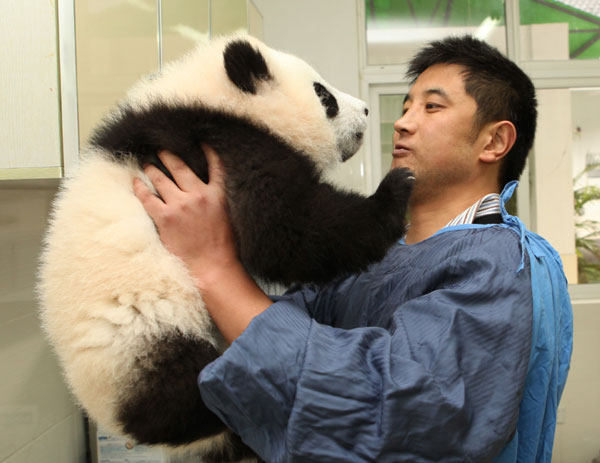Pandas may find traveling hard to bear
Updated: 2012-01-09 08:22
By Jiang Xueqing (China Daily)
|
||||||||
Greater global role has its burdens for our ambassadors of goodwill, Jiang Xueqing reports from Ya'an and Chengdu, Sichuan province.
 |
|
Zhang Yahui, an asistant at the Bifengxia Panda Base in Ya'an, Sichuan province, checks the weight of a 4-month-old panda. [Luo Bo/For China Daily] |
China's giant pandas are on the move again.
Yuan Zai and Huan Huan will leave on Sunday for Beauval Zoo in central France, according to the Chengdu panda research base.
This follows the arrival of another panda pair in Scotland on Dec 4.
Yuan Zai is male and Huan Huan female, and both were born at Chengdu.
Further details were not available but will be announced at a news conference on Tuesday.
Giant pandas have been goodwill ambassadors for China for more than 1,000 years. They still serve that role, but animal conservation and scientific research, both nationally and internationally, play a bigger part.
Although their mission is significant actually getting pandas to a foreign destination has never been easy.
Wu Zetian, the first empress in China during the Tang Dynasty (AD 618-907), is said to have given a pair of pandas and 70 sheets of panda skin to Emperor Temmu of Japan in October 685.
The first person to take a living panda out of China was Ruth Harkness, an American fashion designer. She captured a 6-week-old cub during her exploration of a mountainous region in Wenchuan county, Sichuan province, in 1936. She named the cub Su Lin, which means "a little bit of something cute", after the sister-in-law of her expedition partner, Quentin Young.
With the help of friends, Harkness bribed customs officers to record her as "taking along a barking dog". Su Lin was carried onto the ocean liner President McKinley in a bamboo basket and then outside China. Later, the cub was sent to the Brookfield Zoo in Chicago and attracted as many as 40,000 visitors a day.
Sixteen pandas were taken out of China - some illegally - from 1936 to 1946, according to the Chengdu Research Base. At least 70 dead, stuffed pandas are stored in museums of other countries.
Since 1994, the Chengdu base and China Conservation and Research Center for the Giant Panda in Sichuan have sent at least 26 pandas to the United States, Australia, Japan, Thailand, South Korea, Spain, Austria and the United Kingdom for cooperative research on panda conservation, breeding and veterinary medicine.
The pandas at the Edinburgh Zoo are female Tian Tian (Sweetie) and male Yang Guang (Sunlight), both born in August 2003. They left the Bifengxia Panda Base in Ya'an, Sichuan province, and spent a couple of weeks settling into their new home before public viewing opened on Dec 16.
They will be on loan to the Royal Zoological Society of Scotland for 10 years, and it is hoped they will produce cubs during their stay. The projects make the Edinburgh Zoo the eighth zoo in the Western Hemisphere to have giant pandas, and Beauval will be the ninth.

 Relief reaches isolated village
Relief reaches isolated village
 Rainfall poses new threats to quake-hit region
Rainfall poses new threats to quake-hit region
 Funerals begin for Boston bombing victims
Funerals begin for Boston bombing victims
 Quake takeaway from China's Air Force
Quake takeaway from China's Air Force
 Obama celebrates young inventors at science fair
Obama celebrates young inventors at science fair
 Earth Day marked around the world
Earth Day marked around the world
 Volunteer team helping students find sense of normalcy
Volunteer team helping students find sense of normalcy
 Ethnic groups quick to join rescue efforts
Ethnic groups quick to join rescue efforts
Most Viewed
Editor's Picks

|

|

|

|

|

|
Today's Top News
Health new priority for quake zone
Xi meets US top military officer
Japan's boats driven out of Diaoyu
China mulls online shopping legislation
Bird flu death toll rises to 22
Putin appoints new ambassador to China
Japanese ships blocked from Diaoyu Islands
Inspired by Guan, more Chinese pick up golf
US Weekly

|

|






